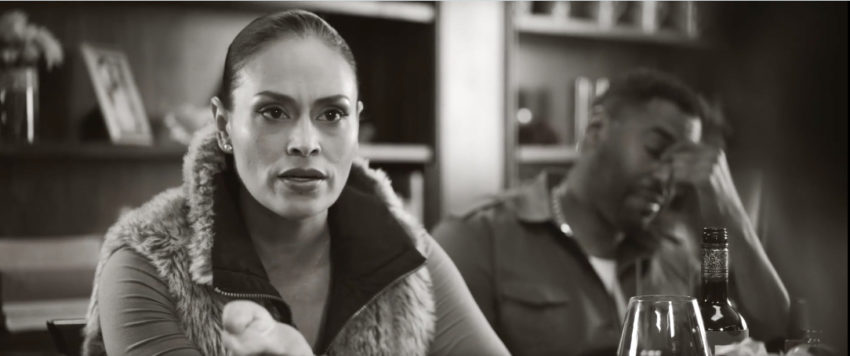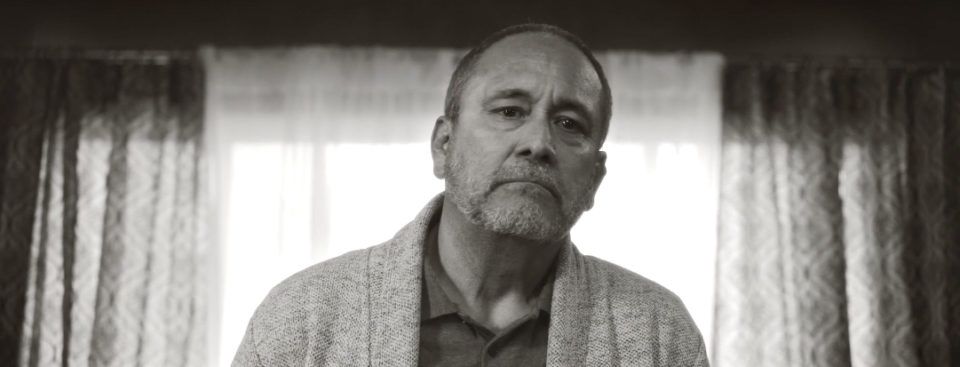
Jessica Meza as Bianca in a scene from Estilo Americano.
LOS ANGELES, CA (LA ELEMENTS) 6/3/2021 – “Come on. Can we just enjoy the American Dream?” seethes Bianca in Estilo Americano, the live action short film written and directed by Miriam Kruishoop.
The opening shot of Estilo Americano certainly reveals something emblematic of the American dream; a house with a swimming pool, two vehicles in the driveway, a yard. All very much the tranquil landscape of the middle class here in the United States. But what transpires inside the house escalates to reveal a family in turmoil.
Patriarch Joachim, (Ruben Garfias) gazes with pride as his adult children have gathered under his roof for a family dinner. There is an abundance of good-natured banter mostly in English but also Spanish among this Mexican American family. There is also lighthearted teasing among the siblings: Bianca, (Jessica Meza), Veronica, (Zuleyka Silver) Danny, (Goya Robles) Miguel, (Antonio Jaramillo) and Raul (Lombardo Boyer). But the merrymaking is broken by the sound of the television playing in the background, as the voice of Donald Trump is heard in one of his campaign commercials. Immediately, Veronica asks that the TV be turned off. And that lights the spark that unleashes years of pent-up resentment, shame and a family secret or two.
Estilo Americano, succeeds in addressing a number of the complexities of Latino identity here in America. Complexities that became more prominent with the election of former president Trump who stirred up a visceral and, in some cases, unpredictable reaction among voters. Indeed, despite his harsh rhetoric aimed at undocumented immigrants at the border, the last election saw Trump gaining more votes from Latinos in the border state of Texas than the previous one. Such seeming contradictions are eloquently addressed in Estilo Americano by the rich and layered portrayal of each character. You can see the flaws in their virtues and the virtues in their flaws.
Miguel for example, can argue convincingly on the merits of immigration, legal or otherwise. He has a vast knowledge of statistics to back up his arguments. But directing his gaze at Raoul when talking about how immigrants are needed because, “white people don’t want to take those low paying jobs,” shows a disconnect of the impact such a statement might make on his brother. Raoul already gets that he is not as successful as his siblings. He doesn’t need to be used as a prop by Miguel to score a political point.
The polar opposite of Raoul would be Bianca, a wealthy, highly educated businesswoman and an ardent Trump supporter. She is proud of her Mexican heritage and yet freely admits that she does not see other Mexicans or Mexican Americans as “my people.” While her success is admirable, one gets the sense that she views her achievements as being an exception within her culture. Like Trump, her disdain for undocumented immigrants stems from the belief that they bring nothing but crime. There is a stunning moment in Estilo Americano, when she misdirects her rage over the perceived crime and poverty brought to this country by immigrants, onto Raoul. Raoul served in Iraq, but after being discharged for reasons not made entirely clear, he was never able to support himself independently. And this begs the question: How can Bianca expect non-Latinos to not look down on people who look like her own brother when she can’t seem to do so herself? Also worth noting is the uncomfortable fact that of all the family members, she is the one who embodies the American success story. At least on the surface. Out of a number of memorable performances in this film, Jessica Meza, (East Los High) leaves a powerful impression. As Bianca, you see a glimpse of the hurt that finally spiraled into the rage of a talented young woman who played by the rules demanded of this country, yet still can’t seem to find happiness.
Estilo Americano takes you on a tension filled journey through the anger and hidden heartbreak of a family on the verge of breaking apart. It does so while giving us characters who demand (and receive) our understanding as to why they feel and act the way that they do in response to what has become one of the most divisive issues of our time. And the fact that this is achieved within the confines of a live action short genre, (23 minutes) is a triumph of storytelling.
Estilo Americano is now screening as part of the Los Angeles Latino International Film Festival. (LALIFF) Visit their site for more information on the complete slate of films showing as well as information on how to buy tickets. You can watch the trailer right here:
ESTILO AMERICANO Trailer from MIKE TEEVEE on Vimeo.
We reached out to Miriam Kruishoop, the director and co-writer of Estilo Americano to learn more about the making of her film. Here is what she had to say about the casting process, the theme and so much more.
The election of Donald Trump was polarizing to so many people here in the U.S. Why did you center your film on the effect that his election had on a Mexican American family? I can pretty much guess why, but I’d like to hear this in your own words.
It was incredibly painful and shocking to see how Trump was bashing an entire demographic who are a quintessential part of American culture and the economy. Having a lot of Latino friends, we started to have discussions about this Trump phenom.
I was also very intrigued why Latinos didn’t stand up more collectively to this bully. What I learned was that there are a lot of divided sentiments about Trump’s narrative and that this had a profound effect on relationships. I started to do more research as I wanted to understand where these different opinions and identities came from. And the more I learned, the stronger I felt about addressing this subject matter as it was becoming a much larger problem that affected any American table. I started to break up with friends and family members and it started to affect our direct surroundings. It was so hurtful to witness a society that was becoming more polarized. I tried to create a story that explores the different opinions and identities that are out there.
It’s important to understand each other and also to realize what really bonds us. In the end, we all want the same thing. We are all connected. We all breathe the same air and rely on the same planet.
Another important element for me was to move away from the Latino stereotypes we so often see portrayed in media and entertainment: the day worker, the maid, etc. I wanted to show a well-educated, middle class family. These are the Latino people that I see around me and are the majority. We should focus more on highlighting these stories. In my work both as a filmmaker and as a visual artist, I try to take away some of the misconceptions that are out there and show a different point of view.
Why did you decide to shoot your film in black and white instead of color?
Even though the subject is very timely, I wanted to give it a timeless and gorgeous feel. After all, film is art. Having eight people stationary at one location, can be boring.
I wanted it to feel very cinematic and got for widescreen framing, the DP David Frederick. I spent a lot of time testing the look of the film. We worked with Sony who gave us their new Sony Venice camera. We tried different lenses and camera movements. We broke down the scenes and the film on two cameras making sure we had enough coverage on everyone. It’s an ensemble piece after all. Sometimes it’s more about the reactions that what’s being said. Even though we had to do the coloring remote, we were able to create a different black and white look with our colorist Beau.
What was the casting process like?
It was very collaborative as there were some personal relationships there. Some of the cast, I just reached out to cold and sent the script. The amazing thing was that anyone who read the project could relate to this personally. These conversations were happening within their family! It became very personal and that was an extra motivation and reason for the actors to join the project and to tell the story. There was an urgency to it and I think that everyone who worked on the film shared that feeling.
I believe this is your second film that deals with a facet of the Latino experience here in the U.S. The first being Green Card Warriors. What is it about that experience that inspires your art?
I respond to what I see around me. Certain things touch me deeply and I’m consumed by the urgency to create something about it. You could say I can have a very emotional response to my surroundings. I see a lot of injustice around me, and I use my storytelling in my filmmaking and visual art to highlight narratives that I believe need more attention.
All my stories are deeply rooted in reality and inspired by true events or people. I want to give a platform to these complex stories in the hope that I can change perspectives. I’d like to build bridges and not walls. In both Greencard Warriors and Estilo Americano, I try to turn stereotypes on their head.
What do you want audiences to take away after seeing your movie?
There is more that bonds us than that divides us. That we need one another. But we have to listen to each other and try to put ourselves in someone else’s shoes. Be accountable for your actions. Don’t judge too fast. Education and equality are everything. They are non-negotiable. Being American means you are an immigrant. We are a mixed society and it’s a beautiful thing. Know that without immigrants, documented and undocumented, America would not be a successful nation. I also believe that religion has no place in politics. America has to come to terms with its history.
Tell us about your next project.
I have a lot of projects lined up but due to the pandemic, things have been falling through or have been delayed. Luckily, things seem to be picking up again. I’m casting two feature films, one in the U.S the other in Europe. Both films address social justice issues. The European film is a story about a young Syrian refugee. The U.S project is a true story about two young girls who meet at a juvenile detention center.
I currently have a show of my visual art from the series, Living In America at Pen + Brush in New York. The works feature Gen Z teens from Watts who take us on a journey what it’s like to be a black teenager in America today. In the fall, I will be having a solo show with new works in Mexico City. I’m really excited about that!
Estilo Americano
Cast
Antonio Jaramillo Miguel
Zuleyka Silver Veronica
Lidia Porto Elena
Lombardo Boyar Raoul
Goya Robles Danny
Jessica Meza Bianca
Ruben Garfias Joachim
Teddy Garces Leon
Director Miriam Kruishoop
Writer Miriam Kruishoop and Laeticia
Rodriguez
Cinematographer David J. Frederick
Film Editor Todd Sandler
Executive Producer Joyce Fitzpatrick, Miriam
Kruishoop, Laeticia Rodriguez and Ellen Utrecht
Follow Miriam Kruishoop on her Instagram.
Follow LA ELEMENTS on Twitter and Instagram. Like us on Facebook.





No Comments